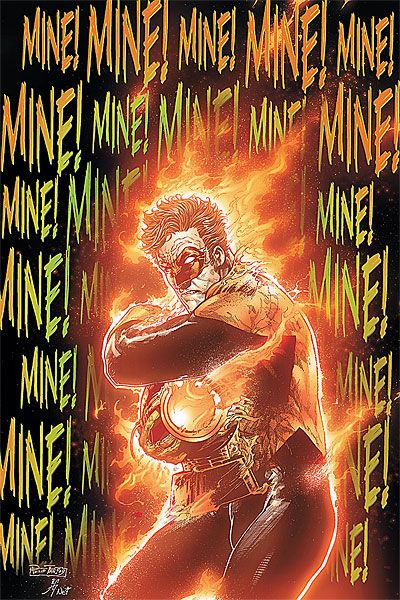One thing jumped out at me from Green Lantern #42 - the coloring of Nei Ruffino and Rob Reis really worked well to give the book a very consistent look even though it had two pencilers who really are not all that similar, Philip Tan and Eddy Barrows. Granted, you could argue that the effect was achieved by darkening things to the point where it blended together (sort of like how darkness in film helps special effects blend together), but in either event, I think it worked. Also, Philip Tan made me feel pretty confident the last couple of issues about seeing him do an arc on Batman and Robin, something I might not have been as confident about prior to this story arc, and while this issue was a bit muddier (that darkness I was referring to), I'm still feeling good about his upcoming arc.
Anyhow, this issue concludes the lead-up to Blackest Night, and writer Geoff Johns has a full plate here, with basically three-four concurrent storylines going on, and I think the last two issues of this story really melded together well for a good lead-in to Blackest Night.
Last issue had a great cliffhanger (you all might know how I feel about cliffhangers being "earned," and I think last issue definitely "earned" its cliffhanger) that was resolved quickly in this issue in a satisfactory manner (and one that was set up earlier in the arc).
The three major stories in this issue were:
Hal Jordan versus Larfleeze, the "Orange Lantern"
John Stewart versus Star Sapphire (who was formerly the villain Fatality)
and
Green Lanterns Ash and Saarek's journey to find the corpse of the Anti-Monitor.
Larfleeze has been a revelation as a villain - an almost comic relief character (if a deadly one at that) who helps break the tension a bit amongst all the seriousness of the lead-up to Blackest Night. Johns handles the humor well here (as he did last issue where we saw Larfleeze's rather humorous origin). I especially dug the bit where Jordan finally recalls the name of the Muppet that Larfleeze reminds him of.
In addition, the usage of the blue ring was well done, particularly where the ring finally kicked in. "Sincerity Registered" - classic.
The John Stewart/Fatality interaction was interesting, although I'm conflicted about the idea of possibly retconning the destruction of Xanshi. Generally, I'm not a fan of re-visiting something that has been more or less resolved for years now to then, I dunno, resolve it again (shades of Janet Van Dyne forgiving Hank Pym then unforgiving him then forgiving him then unforgiving him, etc.). Then again, the original Xanshi plot idea WAS pretty ridiculous (John Stewart, of all people, being arrogant to the point of idiocy, leading to the death of millions? That IS pretty silly), so I suppose it couldn't hurt too much to try to write it off. In any event, the idea of having two characters who are more or less defined by their need to forgive meeting up with each other (with Fatality under the influence of the Zamarons) was a great idea,
Finally (well, not really "finally" as we do first get a little tangent where we see the after effects of Machiavellian Bargain #3545950430553059305935686050 that the Guardians have struck), we see the finale of the mission of Lanterns Saarek and Ash (as an aside - while better than a lot of other captions of this kind - Ash's handwritten captions are still annoying - I am sure that I have seen good handwritten captions somewhere - From Hell, maybe? - but off the top of my head I can't think of any definite examples while I can think of many examples where handwritten captions are hard to read like they are here - although, again, these are at least better than some I have seen - I recall Birds of Prey having AWFUL ones awhile back). Johns adds an extremely nice touch where Saarek (who can hear the dead) has his ear drums burst from all the cries of the dead - and it all leads to an eerie, spooky and highly effective final page (with a great one liner) that leads into Blackest Night #1.
Good stuff - it gives Blackest Night an organic lead-in, which is good to see.
Recommended.
EDITED TO ADD: Commenter rwe1138 did mention a pretty notable mistake that was really odd - early in the issue, Hal says a line of Larfleeze's dialogue. The weird thing is that:
A. Larfleeze has a whole different word balloon design and font, so I'd have thought his dialogue was done separately from Hal's, so it's odd that they would mix together like that.
B. It wasn't even an errant word balloon arrow (you know, like an arrow pointed to the wrong person) - it was just an extra line of dialogue in Hal's otherwise correct dialogue balloon that was clearly not his dialogue.
So weird.


